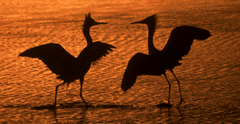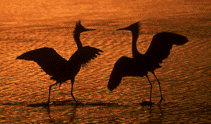|
BIRDS AS ART BULLETIN #24, JUNE 27, 2000
WIMBERLEY HEAD TIPS
> > I took me years to see the light and switch to the regular Wimberley
> > head full time when working first with the Canon 600mm f/4 L lens, and
> now,
> > with the Canon 600mm f/4 L Image Stabilizer lens. Years ago, when I
used
> > the Wimberley head in flight-shooting-only situations, I quickly
realized
> > that in such situations, it was necessary to square the tripod platform
to
> > the world. My preference for flight shooting still is to square the
> platform
> > by adjusting the legs as described in "The Art of Bird Photography."
> Others
> > choose to use the Gitzo leveling head, but I prefer not to add any
> > additional weight to my already too-heavy set-up. And, I have gotten
> really
> > good at adjusting the legs and centering the bubble in the circle on the
> > tripod platform quickly (My Wimberley head is mounted atop a Gitzo 1548
> > Carbon Fiber tripod, the only tripod that I recommend for 600 f/4
lenses.
> I
> > feel that the 1548 is best also for the 500 f/4s, but for folks seeking
to
> > save weight, I can live with the Carbon Fiber 1325 (but not with the
1348
> or
> > 1349, where the lower leg sections are barely thicker than pencils).
> >
> > While working nearly every day with my big rig, I have developed
several
> > strategies not covered in the Amphoto book. Here are the basic
> operational
> > steps that I take every time that I approach a stationary subject and
set
> > the tripod down. First, I loosen the panning knob, point the lens
roughly
> > at the subject, and then tighten the panning knob. Then I loosen the
> tripod
> > collar and square then lens to the world by checking the Hama double
> bubble
> > level in my EOS 1v's hot shoe. I always make sure to finish this step
by
> > rotating the lens clockwise in the tripod collar so that there is no
play
> in
> > the lens mount when I depress the shutter button. Next I frame the
image
> > perfectly by loosening and then tightening first the panning and then
the
> > swing knob. Sometimes it is necessary to loosen and tighten one or both
> of
> > these knobs more than once. When working at slow shutter speeds, I will
> > make a few images quickly and then really crank down on the knobs.
(Note:
> > the one time that I tried a Kirk Cobra Head in the field, it exhibited
> > substantial creep. As you locked the swing knob, the lens moved upwards
> > slightly. This made accurate framing difficult or impossible.
> >
> > When working at extreme focal lengths (1200mm, 1692mm, or 2412mm)
and/or
> > with extremely slow shutter speeds, I have developed a new "maximum
> > sharpness" technique with the Wimberley head that really helps. I place
> my
> > left forearm below the swing knob so that the crook of my arm is
directly
> > below that knob and I place my open left hand palm-down atop the base of
> the
> > lens hood. Short folks will place their left hand on the lens barrel as
> > they will not be able to reach the lens hood; no matter. (Note: you
> should
> > always set your head up so that the swing knob is on the left. Why? So
> > that your right hand is free to depress the shutter button should you be
> > tightening the swing knob when the bird stretches or the fox pup
> yawns.....)
> > As always, I hold the camera body tightly in my right hand with my left
> > cheek pressed firmly against the back of the camera. Now--pardon the
> > pun--for the clincher: I push up firmly with the crook of my left arm,
> push
> > down firmly with my left hand, and pull down firmly on the camera body
> with
> > my right. Thus, the lens is in sort of a vise grip. Then I simply take
> and
> > hold a breath and depress the shutter button.
> >
> > You do not, obviously, want to break your lens in half or damage the
> camera
> > body mount or the lens mount, but using a good, firm, steady pressure
will
> > allow you (with or without Image Stabilization) to make sharper images
> with
> > the Wimberley head than you could otherwise.
> >
> > Important Note: BIRDS AS ART regulars know that it is my firm belief
that
> > to attain maximum sharpness and ensure maximum ease of handling, , a
> > telephoto rig should be precisely balanced atop the tripod head be it
> gimbal
> > type or ball head. To see if your load is properly balanced, first make
> > sure that the Arca-Swiss clamp is fully tightened. Then simply
> > loosen the main locking knob (ball head) or the swing knob (Wimberley)
and
> > see if the rig pitches distinctly forward or backward. If the lens
pitches
> > slightly forward, you will need to move your Really Right Stuff lens
> > mounting plate a bit back in the jaws; if it pitches backward a bit,
then
> > you will need to move the plate forward. If you are not using a Really
> > Right Stuff lens mounting plate, then you are quite foolish and I would
be
> > amazed if you'd read this far anyway.
> >
> > Note: Extreme care must be taken whenever you move the plate to balance
> the
> > load lest the lens hit the ground. You must be sure that the ball head
> main
> > locking knob or the Wimberley swing knob is tightened before loosening
the
> > clamp. It is always best to tighten the clamp before re-checking the
> > balance by loosening either the main locking knob or the swing knob.
And
> I
> > mean always.
> >
> > Lastly, note that the rig needs to be re-balanced each and every time
> that
> > a tele-extender, an extension tube, a flash, or any other accessory is
> added
> > to the mix.
> >
> > If you have read this far, and do not own a copy of "The Art of Bird
> > Photography; The Complete Guide to Professional Field Techniques," then
> > shame on you. Stop what you are doing, visit the web site, and send me
a
> > check for a signed copy right now.
> >
> > Regular Wimberley heads are now in stock: $565 plus $6.50
> shipping
> > includes NEWLY DESIGNED AND MANUFACTURED Wimberley Clamp. New clamps are
> > $100 plus $3.50 shipping. ( In March, I personally witnessed a once-used
> > Kirk clamp FAIL as a brand new Canon 600mm f/4.0 L IS lens was being
> > mounted. The tightening knob stripped the threads from the hole as it
was
> > being tightened. Note: though my Kirk clamp has served me well for many
> > years, I am replacing it with the Wimberley clamp.)
> >
> > Hama Double-Bubble spirit levels are--as always--in stock. See the web
> > site for details.
> >
> > NOTE: Due to a cancellation, there is ONE SPOT available on
> the
> > second Pribilofs IPT, 7/31/2000 to 8/7/2000. See the web site for
details
> > and costs.
> > NOTE: I am looking forward to seeing all NYC area nature photographers
at
> > one of the two Art of Nature Photography Full Day How-To seminars late
> this
> > summer. E-mail us for details. Bring a friend and/or let all of your
> NYC
> > photographer friends know about these exciting seminars.
> >
> > Best and great picture making to all.
> >
> > Arthur Morris/BIRDS AS ART
> >
> > Note: Arthur Morris has been a Canon contract photographer since 1994
and
> > continues in that role today. If you received this bulletin in error,
or
> > would like your name removed from the subscriber list, simply respond by
> > e-mail and request same.
> >
> >
>
>
|


